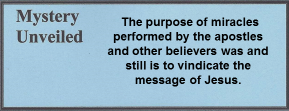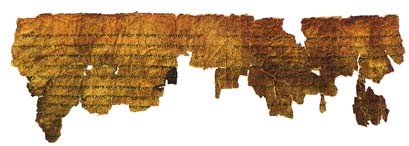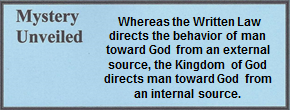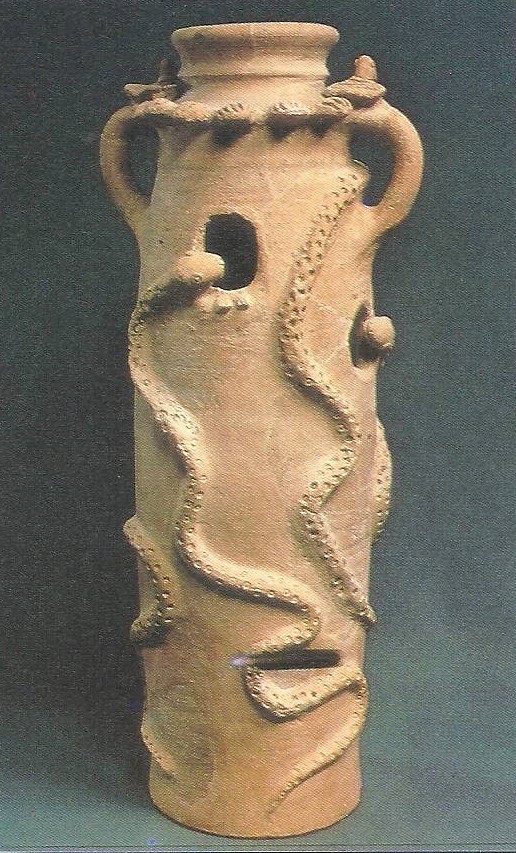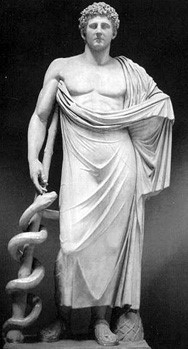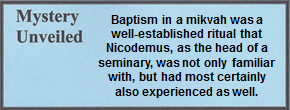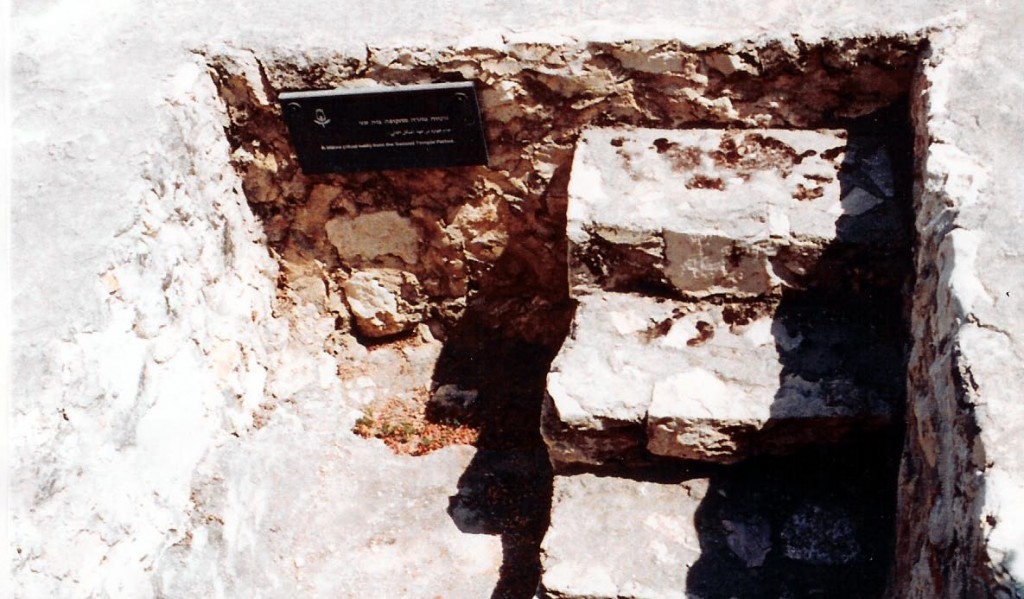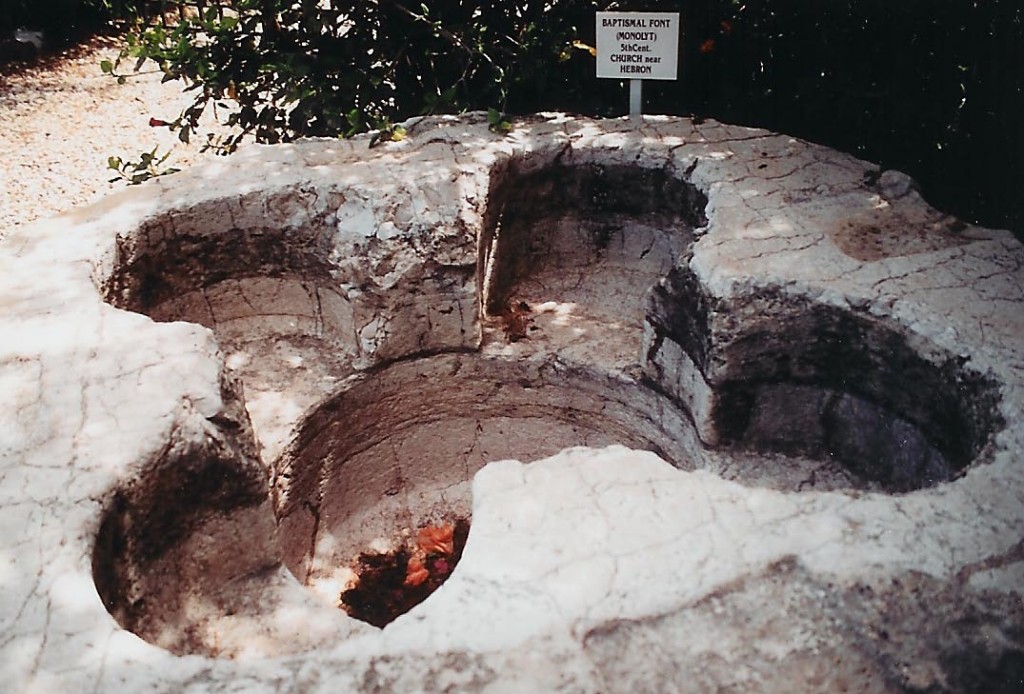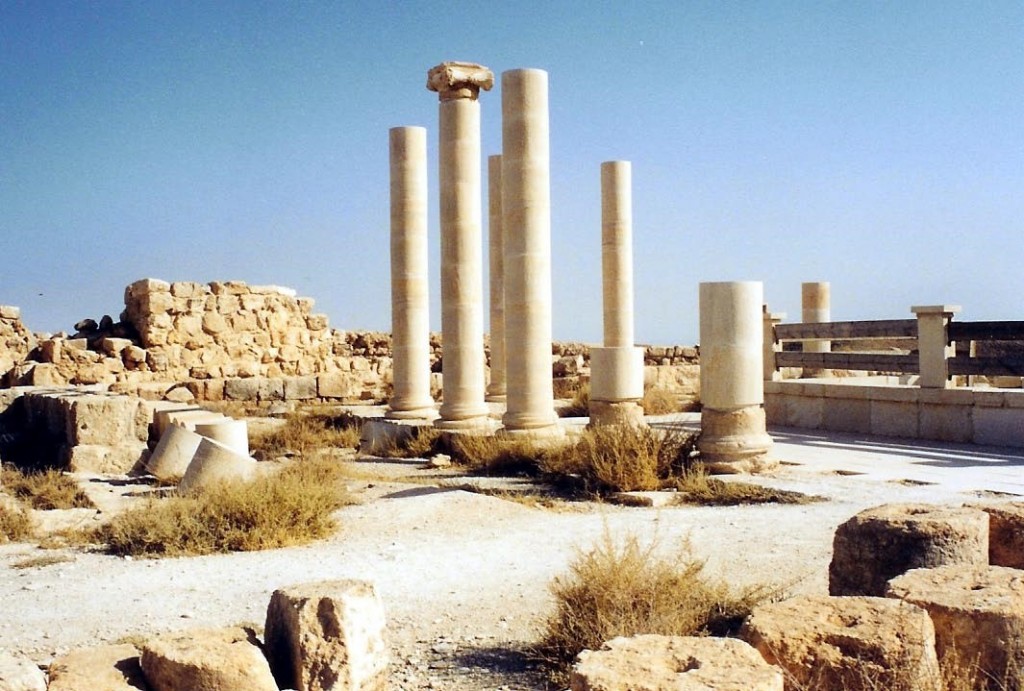05.05.04 Jn. 2:13-25 In the Temple
FIRST TEMPLE CLEANSING, MERCHANTS DRIVEN OUT
13 The Jewish Passover was near, so Jesus went up to Jerusalem. 14 In the temple complex He found people selling oxen, sheep, and doves, and He also found the money changers sitting there. 15 After making a whip out of cords, He drove everyone out of the temple complex with their sheep and oxen. He also poured out the money changers’ coins and overturned the tables. 16 He told those who were selling doves, “Get these things out of here! Stop turning My Father’s house into a marketplace!”
17 And His disciples remembered that it is written: Zeal for Your house will consume Me (Ps. 69:9).
18 So the Jews replied to Him, “What sign of authority will You show us for doing these things?”
19 Jesus answered, “Destroy this sanctuary, and I will raise it up in three days.”
20 Therefore the Jews said, “This sanctuary took 46 years to build, and will You raise it up in three days?”
21 But He was speaking about the sanctuary of His body. 22 So when He was raised from the dead, His disciples remembered that He had said this. And they believed the Scripture and the statement Jesus had made.
23 While He was in Jerusalem at the Passover Festival, many trusted in His name when they saw the signs He was doing. 24 Jesus, however, would not entrust Himself to them, since He knew them all 25 and because He did not need anyone to testify about man; for He Himself knew what was in man.
Jesus went to Jerusalem to observe Passover for the first time since He began His ministry.[1] He had been there many times in earlier years, and knew the corrupt business climate that had taken control of the House of Prayer. This was the first of two recorded temple cleansings; symbolically, He opened and closed His ministry with a call to purity of the people of God.[2]
“He found people selling . . . money changers sitting there.” When Jesus entered the temple, He found agents for the high priest selling animals and exchanging currency at inflated rates. Currency exchangers functioned at the temple year round, but they were especially active at Passover. This commercial business activity became known as the Bazaars of Annas, located in the Court of the Gentiles.[3] Only Annas was qualified to certify if an animal was pure, spotless, and unblemished and, therefore, perfect for sacrifice. In the event he rejected an animal, he was quick to have an “approved” animal available for purchase at a premium price. Since many local people were involved with agriculture they frequently raised their own animals for sacrifice. But all animals had to be approved by Annas who was known for rejecting perfectly good animals for the sole purpose of reselling them to someone else at inflated prices. Furthermore, many people traveled great distances to the temple and Annas took advantage of their plight by overcharging them ten to twenty times the fair market value.[4] The Talmud records an incident of such price gouging:
Once in Jerusalem a pair of doves cost a golden dinar. Rabban Simeon ben Gamaliel said, “By this temple, I will not suffer the night to pass by before they cost but a (silver) dinar.” He went into the court and taught: “If a woman suffered five miscarriages that were not in doubt or five issues that were not in doubt, she need bring but one offering, and she may then eat of the animal offerings; and she is not bound to offer the other offerings. And the same day the price of a pair of doves stood at a quarter-dinar each.”
Mishnah, Kerithoth 1:7[5]
The significance of either a silver or a golden dinar being the price of a pair of doves is that a pair of doves was the offering from the poorest people of Israel. The temple elite clearly had no compassion for anyone but themselves.
From the fifteenth day of the month preceding Passover, bankers set up their tables throughout the city, and from twenty days prior to Passover they were permitted to trade within the temple itself.[6] Passover was also the time when the annual half shekel temple tax had to be paid (Ex. 30:11-16). Foreign coins were generally rejected by Annas, supposedly because these coins generally had images of pagan gods. However, the more likely reason was that these coins did not have a consistent precious metal value, with the exception of coins minted in Tyre. For those who came with foreign currency, Annas charged them a premium between four to eight percent, so they could place pure (94%) Tyrian shekels[7] into the temple coffers.[8] These shekels and half-shekels were known for having the purest silver content of any mint in the ancient Middle East. That was far more important to Annas than the image of Marduk, a/k/a Melqarth-Herakles that was stamped on the coin. Little wonder that the Pharisees had a passionate hatred for the Hellenized Sadducees.
But the crimes of Annas did not end there. His bazaar was located in the Gentile Court of the temple and the resulting atmosphere was more of a livestock auction than a place of worship. Clearly the retired high priest had great disdain for the Jewish people he was supposed to represent before God, but he had even less respect for Gentiles.
Tradition says that a certain Babh Ben Buta was the first to commercialize it when he brought a flock of 3,000 sheep from Kadar.[9] This business venture would never have happened if the high priest Annas had not approved it. The Gentile Court, which was to be a House of Prayer for all nations, had been degraded into a foul-smelling livestock market with its currency exchange bankers. Those who were employed by Annas were profit-oriented, while the worshipers were forced to defend themselves against temple swindlers, bankers, and hucksters.[10] Clearly, the livestock business was a highly lucrative endeavor. The irony is, that those who claimed Jesus profaned the temple were the ones profiting from the profaning that occurred on a weekly basis, but more so at Passover.
Finally, his greed was beyond description. For example, from the altar there was a pipe in which flowed the blood from the sacrificial animals into the Kidron Valley. That blood was collected, dried, and sold to gardeners who used for fertilizer.[11] There was good reason that the common Jews hated House of Annas as much as the Herodian family.
“A whip out of cords.” No weapons were permitted in the temple area. This included sticks and whips that were normally used to drive animals. Therefore, Jesus quickly made a short rope (Gk. schoinion 4979)[12] out of twisted rushes, or bul-rush, thereby creating a rush-rope.[13] With it He scolded the merchants as He drove them out of the Gentile Court and into the streets. His action was a message everyone understood, and no one, not even the Roman guards who were stationed in the adjacent Antonia Fortress, took action against Him. Judas Maccabee would have been proud of Him. His actions undoubtedly caught the attention of many, including the Zealots.
Jesus never intended to cleanse the temple from its divinely appointed system of sacrifices, but from the incredible corruption and abuses. On several occasions He healed people and told them to make the required sacrifices in the temple.[14] It was a holy site for worship but the current activities were an affront to God. The prophet Zechariah said that in the days of the Messiah, no trader (or “Canaanite”)[15] would be in the house of Jehovah and holiness would be restored (Zech. 14:20-21).
20 On that day, the words HOLY TO THE LORD will be on the bells of the horses. The pots in the house of the Lord will be like the sprinkling basins before the altar. 21 Every pot in Jerusalem and in Judah will be holy to the Lord of Hosts. Everyone who sacrifices will come and take some of the pots to cook in. And on that day there will no longer be a Canaanite in the house of the Lord of Hosts.
Zechariah 14:20-21
The rabbis must have wondered if Zechariah’s prophecy was fulfilled, and if so, when the rest of the prophecy would be fulfilled. Clearly, cleansing the temple called attention prophetic scriptures and to His identity as the messiah.
“This sanctuary took 46 years to build, and will You raise it up in three days?” These words sent shock waves throughout the rabbinic community and temple establishment. They knew that the temple described in Ezekiel (Ch. 40 ff.) was not the temple they so highly cherished. If Ezekiel’s prophecy was to come true, as did so many other of his prophecies, then clearly the present temple would have to be destroyed to permit the construction of the one prophesied. That change would destroy the power and wealth system of the ruling class and no one dared to speak of such a destruction or replacement.
Yet, to add turbulence to their thinking, Jesus said He would raise it in three days. When they realized He could heal the blind, make the lame walk, and raise the dead, their fear of a new temple was most threatening. No wonder they made certain someone would accuse Him of destroying the Holy Shrine. In fact, the law required anyone who threatened the destruction of the temple be put to death. While Jesus did not say He would do this, His words came close. He referred to the “reconstruction of the temple” as His body resurrected from the grave. Jesus never said, “I am able to destroy the temple of God,” or “I will destroy this temple….” But those were distortions later said by two false witnesses who accused Him during His trial (Mt. 26:61; Mk. 14:57-58).
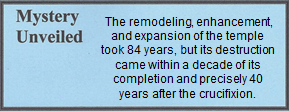
In the phrase, “this sanctuary took 46 years to build,” the Greek wording clearly indicates construction was still in progress. In fact, the temple reconstruction began in Herod the Great’s 18th year of reign,[16] reckoned to be 20-19 B.C., and was not completed until A.D. 64, only six years before its destruction. Since the discussion between Jesus and His adversaries took place in the 46th year of reconstruction, the date can be accurately connected to the 15th year of reign for Tiberius Caesar (Lk. 3:1), which in the modern calendar was A.D. 27.[17] Some scholars have argued for a beginning date of A.D. 28 (or 791 AUC the founding of Rome). However, their calculation fails to recognize that the Jews considered part of a year as a full year, in the same manner as they considered part of a day as a full day (i.e. crucifixion day to resurrection day equals three days).[18] It is a strong argument for a crucifixion date of A.D. 30, which presupposes a ministry of three and a half years.[19]
It should be noted that the 46th year was not the year of the temple’s completion, as some have suggested. In fact, the Talmud indicates that the temple was still under reconstruction during the days of Rabbi Gamaliel the Elder,[20] and Josephus said that the all the work was finally completed in the days of Albinus,[21] which was just prior to the First Revolt and the temple’s ultimate destruction.[22]
“Many trusted in His name when they saw the signs He was doing.” The early teaching ministry of Jesus must have been impressive, because by the time He attended the wedding in Cana, He had gathered five of His twelve disciples without performing any miracles. In fact, they probably didn’t even know Jesus could perform such feats. Therefore, the water-to-wine miracle brought incredible attention, the first of many, which John called signs or semeion (4956).[23]
Multitudes came from many parts of the world for the Passover celebration. While in Jerusalem they most certainly heard all the chatter and latest gossip about the Man who changed water into wine and threw out the money changers. When they returned to home the news spread like a wildfire. While His ministry was essentially in a very small geographical area, His influence reached throughout the empire.
This was the first of two cleansings. While some scholars believe there was only one cleansing which was recorded twice, there clearly is a major difference between the two – after the first cleansing Jesus continued in His ministry. After the second one, He was crucified. However there is an important point to consider, one that has often been missed: the appearance of Jesus was a fulfillment of a prophecy by Malachi, and as such, the cleansing was a bold messianic claim.
“See, I am going to send My messenger, and he will clear the way before Me. Then the Lord you seek will suddenly come to His temple, the Messenger of the covenant you desire—see, He is coming,” says the Lord of Hosts.
Malachi 3:1
Because of these words by the prophet Malachi, there was a common belief that when the messiah comes, there would be a new era of holiness and purity in temple worship. This is found in several Jewish writings,[24] as well as in the Eighteen Benedictions.[25] The beginning of this verse clearly refers to John the Baptist. But the second sentence refers to Jesus who suddenly came to the temple (see 13.02.02) and, in doing so, made a profound messianic claim without a spoken word.[26]
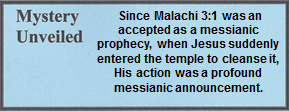
The cleansing was not an action against the temple, but against the merchants in the Court of the Gentiles. By these cleansings, Jesus also fulfilled a prophecy in Psalm 69 that reads,
For your house has consumed me,
Psalm 69:9a
The verse literally means that the temple will be His destruction.[27] This is precisely what happened. The Sadducees were delighted to see Jesus challenge and humiliate the Pharisees, but when He cleansed the temple, He was threatening their turf – their social, economic, and political security, and they planned to kill Him. The primary reason for the cleansing was that the Gentile Court of the temple complex had been converted from a Holy Site to a massive commercial enterprise for the personal financial benefit of the high priest, Annas.
It should be noted that there was a wall of division between the Gentile Court and the Court of Israel. That wall had a warning engraved on at least two stones (see 13.02.02.A), one of which reads as follows:
No stranger is to enter within the balustrade (partition barrier) surrounding the temple and whoever is caught will be answerable for his death, which will ensue.
Josephus, Antiquities. 12.3.4 (145b)[28]

There are two significant points to consider which are followed by the discussion of the temple as a sacrificial system and significant people affiliated with the temple who also functioned as a private banking system. The days when the temple was a House of Prayer were essentially gone – as only a few righteous priests and Levites continued to function in their service as per the biblical mandates.
- The temple was the shrine of the national religion and center of public life. Only the righteous (as defined by the religious elite) could worship there. The structure had become an idol, and to speak against it could mean death. Into this religious environment, Jesus boldly announced the corruption of the established religion. Jesus came and found a decadent temple, rather than what it was supposed to be – a holy temple where all mankind could come to sacrifice and worship God.
- The Essenes established an independent religious community at Qumran in the second century B.C. because of the corruption of the temple establishment – the most corrupted leadership in the six centuries of the temple’s existence (515 B.C. – A.D. 70). The sins of the Sadducees, who controlled the temple affairs, were prophetically described centuries earlier in Psalm 69:9. Not only did Jesus condemn them, but Josephus likewise mentions them in his book Antiquities of the Jews.[29] Centuries after Jesus, the writers of the Babylonian and Jerusalem Talmuds also condemned them. The high priesthood reached the pinnacle of greed and defiled the temple in two ways:[30]
- The leading Pharisees and Sadducees converted the sacrificial system into a moneymaking machine for their personal wealth.
- The temple or various priestly families of the temple continued to function as a private bank for the Jews. Both features are discussed below.
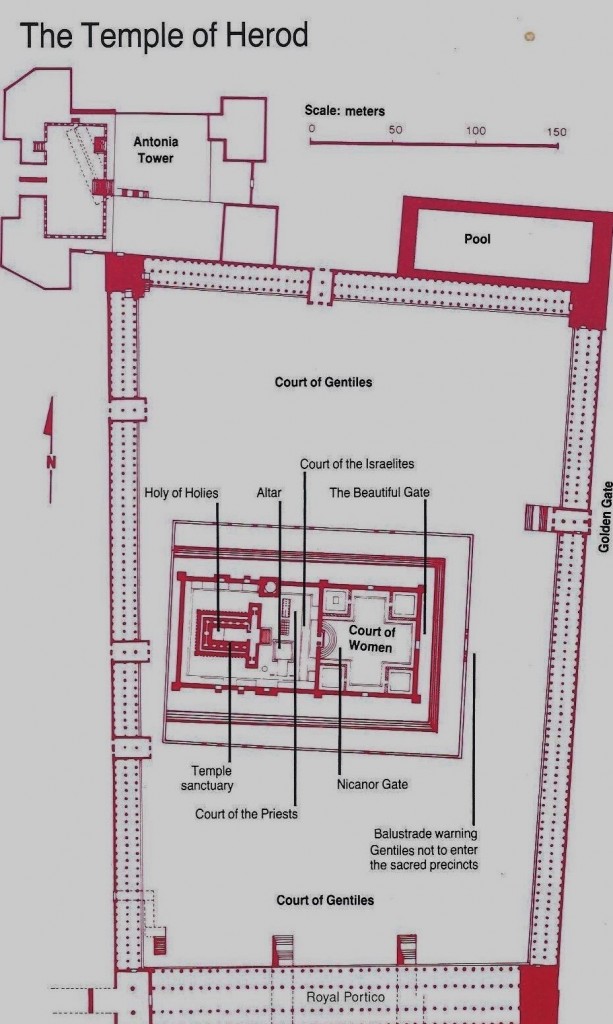
05.05.04.A. FLOOR PLAN OF HEROD’S TEMPLE. The Court of the Gentiles was a large area that surrounded the more sacred areas of the temple. The Court had been converted into a commercial banking and livestock sales area in Jesus’ day.
The small city of Jerusalem brimmed with hundreds of thousands of visitors during the springtime festival of Passover. It was so congested that many brought their own food and slept outside the city under the starry sky in places like the Garden of Gethsemane. In fact, Jerusalem had become such a popular tourist center, with Jewish pilgrims coming from all parts of the Mediterranean world that scholars believe a synagogue with hotel accommodations was built primarily for them. In 1913 the Theodotus inscription was discovered in the bottom of a well in Jerusalem. However, it is also believed that the facility served as a school between festivals when the “tourist trade” declined.
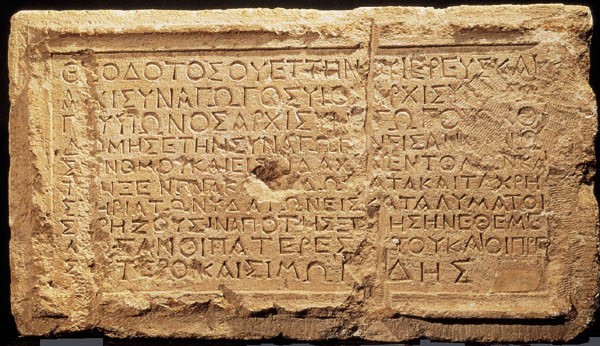
05.05.04.B. THE THEODOTUS INSCRIPTION. The Theodotus inscription was at one time at the entrance of a Jerusalem synagogue which was destroyed by the Romans in A.D. 70. It is believed to have been built for Jewish pilgrims who desired a bath and place for lodging. Wikipedia Commons.
The inscribed stone reads as follows:
Theodotus son of Vettenus, priest and synagogue leader, son of a synagogue leader, grandson of a synagogue leader, rebuilt this synagogue for the reading of the Law and the teaching of the commandments, and the hostelry, rooms and baths, for the lodging of those who have need from abroad. It was established by his forefathers, the elders and Simonides.
Theodotus Inscription[31]
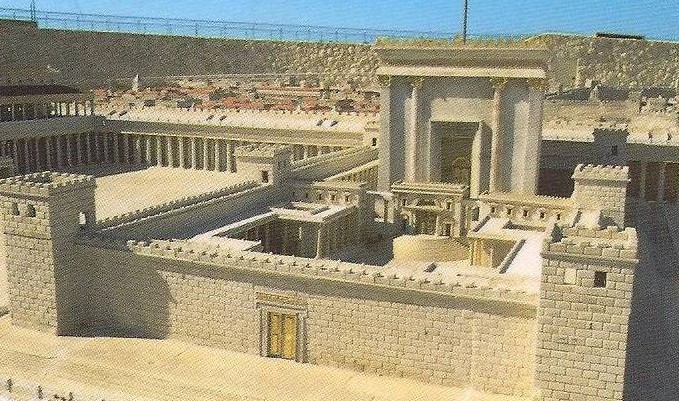
05.05.04.C. A MODEL OF THE TEMPLE AND COURT OF THE WOMEN (behind the wall). The Court of the Gentiles was the large area to the extreme right and left sides as well as the immediate foreground. Photograph by Wikipedia Commons.
- The Sacrificial System.
The Jews celebrated their God, in part, with seven festivals that were combined in three events, of which the Passover was the most significant (Ex. 20).[32] Every male Jew, who lived within fifteen Roman miles, was expected to participate. However, it was such a highly esteemed celebration that every Jewish man, particularly those in distant lands, dreamed of visiting the holy city at least once in his lifetime.
This gave the aristocratic Sadducees, namely the house of Caiaphas and Annas, the annual extortion opportunity to overcharge these visitors for sacrificial animals needed for their most sacred worship service. The vast number of sheep, oxen, and doves sold to visiting pilgrims in the temple transformed the place of worship into a marketplace to benefit the well-to-do Sadducees. The noise, filth, and stench were most certainly unbearable.
- The Banking System.
The Court of the Gentiles had become a house of merchandise, of bartering and bickering, and a banking center.[33] It was supposed to be a House of Prayer where men and women from all nations could pray to the Almighty God of heaven and earth. Instead, it was a system of elaborate commercial enterprises which produced enormous wealth for a few aristocrats.[34]
In ancient times, the common belief was that gods lived in the temple where the people worshiped. This was true of every ancient culture worldwide, not only in the Middle East. People trusted their gods to protect them and provide for their daily needs. Temples were always considered a safe haven because the gods lived there and would protect people and property. Furthermore, no one dared to steal monies given to the gods or stored in the holy sanctuaries, because it was feared that the gods would retaliate and curse the thief, whether he be a king or a pauper. When Solomon’s temple was burned in 587 B.C., the Israelites believed that the Babylonians had defeated their God. Hence, prophets such as Daniel and Ezekiel gave prophetic words to tell their people that their God was very much alive and in control. Centuries earlier when Joshua traveled from Jericho north to Hazor, he burned the entire city, including its temple and royal palaces. Since Hazor was the largest of the Canaanite cities, Joshua’s victory, including the destruction of the Canaanite temple, sent shivers of fear through the hearts of all of the other Canaanite communities. It was obvious to everyone that the God of Joshua was more powerful than the god of the Canaanites.
In every society, as a few individuals became wealthy, they needed a place to store their funds. The only place available was the nearby temple, which became the first bank. The temple-banking system became well developed during the Hellenistic Period in cities such as Delos, Sardis, Claris, Pessinus, Mylasa, Aymus, and Caria.[35] In Ephesus, for example, the temple of the goddess Diana served as the central bank for the eastern third of the Roman Empire. The wealth that flowed into that city was enormous. Deposits grew and as people needed to borrow money, wealthy individuals within the temple became the first lenders. While the Israelites were in Babylonian captivity, they became familiar with Babylonian lending institutions. Archaeological evidence clearly shows that some Jewish families became very wealthy in the banking industry.[36] Religions and temples were closely aligned with governments. Now, not only was the money of the wealthy safely secured, but incredible sums of money also were given to the temple by the devotees of the faith. Hence, trustworthy priests could serve as mortgage brokers and earn a commission on money lent out. Thousands of texts written on clay tablets found in Mesopotamia indicate the average interest rate of twenty percent, which was easy for anyone to calculate using fingers.[37] It was also the established interest rate for redeeming part of a tithe (Lev. 27:31).[38] In temple complex was the Royal Stoa Building, the financial facility that housed cash reserves, notes of debts, mortgages, expensive fabrics and other objects of extreme value.[39]
Video Insert >
05.05.04.V1 The Temple Role in the Banking System. Professor Gary Byers and Dr. Paul Wright discuss what scholars believe was a private banking system affiliated with the religious establishment in the temple. Introduction by Dr. Bill Heinrich. Click here if Internet connection is available.
In one of His parables, Jesus asked the question, “Why didn’t you put my money in the bank?”(Lk. 19:23). So clearly, there was some type of lending-saving financial institution operating at the time.[40] Some scholars believe that in all probability, it was a private institution connected with the temple. In Jerusalem there were merchants who evidently did considerable business and needed a place to keep their money.[41] The safest place evidently was the Counting House, which was related to the temple – not physically, but probably owned by the temple but located elsewhere in the city.[42] Some scholars have suggested the Counting House was located outside the city,[43] but this is doubtful for security reasons.
At this time there was no modern-style institutionalized banking system, although there is clear evidence that the aristocrats and super rich stored their wealth in the temple.[44] Josephus, in his eye-witness description of the destruction of Jerusalem and the temple, said,
They also burnt down the treasury chambers, in which was an immense quantity of money, and an immense number of garments, and other precious goods, there deposited; and to speak all in a few words, there it was that the entire riches of the Jews were heaped up together.
Josephus, Wars 6.5.2 (282)
Among the wealthy who were private lenders, were tax collectors. Josephus recorded the account of one by the name of Joseph, son of Tobias of the second century (B.C.). His relation as a nephew to the high priest in Jerusalem most certainly was a factor in acquiring this position, which he held for twenty-two years. From his office in Jerusalem, he collected taxes from Syria, Phoenicia, Israel, and Samaria. In addition, he had an office in Alexandria which was operated by his steward. Tax collectors such as Joseph often became private lenders, a tradition that was already well-established in Old Testament times (Isa. 5:8; Micah 2:1-5). Peasants who did not have funds mortgaged their lands and crops, thus becoming poorer while the tax collectors became wealthier.[45] That is why the prophet Isaiah condemned them when he said,
Woe to those who add house to house
And join field to field
Until there is no more room
And you alone are left in the field
Isaiah 5:8
The prophet Micah likewise condemned the tax collectors saying that they deprived people of their homes and inheritances to the point of creating a national disaster. The problem for the tax collector was where to store the thousands of coins until shipment was made to the royal treasury? Money was stored in the temple. That is why there was a Roman auxiliary unit stationed in Capernaum where Matthew was the tax collector and why there was a fortress by the temple in Jerusalem.
In addition to being a Roman-protected “safe deposit box” for ancient wealth, the temple was the most important factor in the commerce of Jerusalem. A number of shopping areas, called bazaars, were located nearby where pilgrims could purchase goods made locally as well as imports.[46] So much money was generated from local businesses, that a number of ancient writers said that people were invited to store their wealth in the temple,[47] but it was not just for the rich and famous, widows and orphans also used this facility (2 Macc. 3:10). With so much money in the temple, supervision and security of the deposits was critical. There were no less than three treasurers, or gizbarim,[48] who reported to the captain of the temple.[49] They were responsible for all financial transactions, which included the following:
- Deposits of monetary funds.
- Deposits of goods (grain, animals, dough, etc.) equivalent to money[50]
- Deposits of all other offerings, including second tithes
- Secured payments of the temple tax as mentioned in Matthew 17:24.[51]
Video Insert >
05.05.04.V2 The Temple Cleansing. Professor Gary Byers discusses the cleansing of the temple.
Due to the fact that there was a huge amount of silver and gold in the temple treasury, there was a need for security. The temple police were the responsibility of the Levites who assigned Levitical guards to twenty-one posts while the priests guarded three posts within the sacred area.[52] Previously, when the Jews were taken to Babylon, they were introduced to a highly developed lending system. A study of the Hebrew Bible and Inter-Testamental books reveal some clues indicating that lending not only existed, but was also abusive, hundreds of years before Christ.[53] Notice the following examples:
- After a number of poor crop harvests, unfortunate happenings and possible extravagance led to huge debts (Neh. 5:3-4).
- The wealthy and prosperous were expected to lend to the poor without charging interest.[54]
- When David was struggling for his position, among those with him were debtors who joined him in the Cave of Adullam (1 Sam. 22:2). They probably joined him due to the harsh punishment they would have received for failure of payment (cf. Ps. 37:21).
These accounts appear to be related to private individuals as there is no mention of commercial lending through the temple. Therefore, the narrative written by Jason of Cyrene[55] in 2 Maccabees 3:10-14 is perplexing, because it is the report of an agent for the Greek Seleucid king who attempted to steal private monies from the temple. It reads as follows:
He reported to him that the treasury in Jerusalem was full of untold sums of money, so that the amount of the funds could not be reckoned, and that they did not belong to the account of the sacrifices, but that it was possible for them to fall under the control of the king.
When Apollonius met with the king, he told him of the money about which he had been informed. The king chose Heliodorus, who was in charge of his affairs, and sent him with commands to effect the removal of the aforesaid money. Heliodorus at once set out on his journey, ostensibly to make a tour of inspection of the cities of Coelesyria and Phoenicia, but in fact to carry out the king’s purpose.
When he arrived in Jerusalem he had been kindly welcomed by the high priest of the city, he told him about the disclosure that had been made and stated why he had come, and he inquired whether this really was the situation. The high priest explained that there were some deposits belonging to widows and orphans,[56] and also some money of Hyrcanus, son of Tobias, a man of very prominent position, and that totaled in all four hundred talents of silver and two hundred talents of gold.[57] To such an extent, the impious Simon had misrepresented the facts. And he said that it was utterly impossible that wrong should be done to those people and in the sanctity and inviolability of the temple, which is honored throughout the whole world. But Heliodorus, because of the king’s commands which he had, said that this money must in any case be confiscated for the king’s treasury. So he set a day and went in to direct the inspection of these funds.
There was no little distress throughout the whole city. The priests prostrated themselves before the altar in their priestly garments and called toward heaven upon him who had given the law about deposits, that he should keep them safe for those who had deposited them. To see the appearance of the high priest was to be wounded at heart, for his face and the change in his color disclosed the anguish of his soul. For terror and bodily trembling had come over the man, which plainly showed to those who looked at him the pain lodged in his heart. People also hurried out of their houses in crowds to make a general supplication because the holy place was about to be brought under contempt. Women, girded with sackcloth under their breasts, thronged the streets. Some of the maidens who were kept indoors ran together to the gates, and some to the walls, while others peered out of windows. And holding up their hands to heaven, they all made entreaty. There was something pitiable in the prostration of the whole populace and the anxiety of the high priest in his great anguish.
While they were calling upon the Almighty Lord that he would keep what had been entrusted safe and secure for those who had entrusted it, Heliodorus went on with what had been decided. But when he arrived at the treasury with his bodyguard, then and there the Sovereign of spirits and of all authority caused so great a manifestation that all who had been so bold as to accompany him were astounded by the power of God, and became faint with terror. For there appeared to them a magnificently caparisoned horse, with a rider of frightening mien, and it rushed furiously at Heliodorus and struck at him with its front hoofs. Its rider was seen to have armor and weapons of gold.
Two young men also appeared to him, remarkably strong, gloriously beautiful and splendidly dressed who stood on each side of him and scourged him continuously, inflicting many blows on him. When he suddenly fell to the ground and deep darkness came over him, his men took him up and put him on a stretcher and carried him away, this man who had just entered the aforesaid treasury with a great retinue and all his bodyguard but was now unable to help himself; and they recognized clearly the sovereign power of God. While he lay prostrate, speechless because of the divine intervention and deprived of any hope of recovery, they praised the Lord who had acted marvelously for his own place. And the temple, which a little while before was full of fear and disturbance, was filled with joy and gladness, now that the Almighty Lord had appeared.
2 Maccabees 2:6-30
This historical narrative not only provides evidence of influential lending families within the temple, but also shows that God moved in a profound way to protect. There has been little research made on the relationship of the Jewish temple and private banking system, yet it appears to have been common practice for the two to function together similar to that of other ancient cultures in the Middle East. Concerning the corruption of the aristocratic temple Sadducees, there is no shortage of graphic expressions by the writers of the Mishnah.
The daughters of the Samaritans are deemed unclean as menstruates from their cradle and the Samaritans convey uncleanness to what lies beneath them…. The daughters of the Sadducees, if they follow after the ways of their fathers, are deemed to be like the women of the Samaritans; but if they have separated themselves and follow after the ways of the Israelites, they are deemed to be like the women of the Israelites.
Mishnah, Niddah 4.1-2
Josephus said Pilate stole temple funds to build an aqueduct to serve the temple.[58] This project was begun by Herod before his death. Note the words of Josephus, as these imply the people were upset, not so much that their money was gone, but that Pilate stole sacred monies.
After this he raised another disturbance by expending that sacred treasure which is called “Corban,”[59] upon the aqueducts, thereby he brought water from four hundred furlongs. At this, the multitude was indignant; and when Pilate came to Jerusalem, they came about his tribunal and made a clamor at it.
Josephus, Wars 2.9.4 (175)
The maintenance of the infrastructure of Jerusalem – the walls, water-channels, towers, storm sewers, maintenance workers and street sweepers[60] – were all paid for by the temple.[61] The irony is that when Pilate raided temple funds to complete the construction of the aqueduct, he essentially finished the work that the religious aristocrats were supposed to have done in the first place. When the Romans destroyed the temple during the First Revolt, they burned down the various chambers (rooms) of the temple complex. Josephus, who was an eye witness, recorded the following,
And now the Romans, judging that it was in vain to spare what was around the holy house (meaning the temple itself), burned all those places, and the remains of the cloisters, and the gates except two; the one on the east side and the one on the south side; both of which, however, burned afterwards. They also burned the treasury chambers, in which was an immense quantity of money, and an immense number of garments, and other precious goods, there deposited; and to say in a few words, there it was that the entire riches of the Jews were heaped up together.
Josephus, Wars 6.5.2 (281-282)
The treasury chambers (rooms) that Josephus referred to were probably the same ones that John mentioned when describing the discussion Jesus had by the treasury in John 8:20.[62] Since the temples functioned as “safe deposit boxes” in banks, the private bankers, a/k/a money changers (Gk. kollubistes, 2855 – derived from kollubos, meaning money clippers)[63] were responsible for all phases of banking, including currency exchange. It was connected with the Greek word philarguia (5365), from phileo, meaning to love, and arguros, meaning silver.[64] The English word banker is derived from the ancient money changers. The changers of money or money changers, (kollubistai)[65] sat at a table, bench, banque or banca precisely as described in the temple narratives.[66] The money changers in the temple also charged the people high exchange rates for currency and sold sacrificial animals at inflated prices.[67]
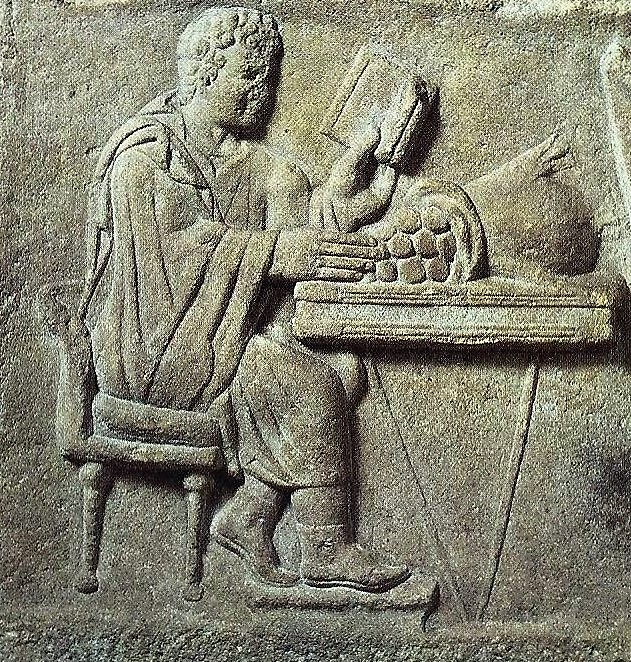 05.05.04.D. A ROMAN RELIEF OF A BANKER AT WORK. This relief carving shows a banker with his money bag and book of records at work. The huge volume of money donated to temples, as well as deposits held for security reasons, resulted in temples becoming banking institutions throughout the ancient world. Relief on a Roman era funerary stele from Hungary. Photograph by Wikipedia Commons.
05.05.04.D. A ROMAN RELIEF OF A BANKER AT WORK. This relief carving shows a banker with his money bag and book of records at work. The huge volume of money donated to temples, as well as deposits held for security reasons, resulted in temples becoming banking institutions throughout the ancient world. Relief on a Roman era funerary stele from Hungary. Photograph by Wikipedia Commons.
Finally, the fourth gospel tells us Jesus went to Jerusalem for two feasts. These occurred in the spring and would have been the Passover observances. He essentially began and ended His ministry with the cleansing of the temple, symbolic of the ministry and culmination of His life, to cleanse the hearts of the people to be His temple.
05.05.04.Q1 What is the evidence against the existence of a temple banking system Jn. 2:14)?
The question of a possible banking system centers on the money changers of the temple as well as the management of temple and business funding in general. Scripture does not address this matter directly, but repeatedly indicates the temple was to be a place of worship and the dwelling place of the Most High God. As previously stated, recent scholarship suggests that wealthy families in Jerusalem established private banking systems that centuries later, became commercial enterprises. The Mishnah and both Talmuds were written by rabbis who desired to see the temple rebuilt, services restored, and God honored. They preserved incredible details and, at times, harsh criticisms of their own priests, but they made no mention of a commercial lending institution. They vehemently opposed the activities of those who were like Annas and Caiaphas who gained incredible wealth by lending and exploiting of fellow Jews.
Nonetheless, there is sufficient evidence to suggest that some wealthy families affiliated with the temple functioned as private lending institutions.[68] It would have been one of those families whom Jesus referred to in His parable of the talents, when He told a servant that instead of burying the talent, he could have placed it in a bank and received a minimal interest.[69]
[1]. Jesus went to at least three Passovers during His ministry years (Jn. 2:13; 6:4; and 11:55) and attended another feast that was not identified but is believed to have been a Passover celebration (5:1). He also attended the Feast of Tabernacles (Jn. 7:2, 10) and the Feast of Dedication (Jn. 10:22).
[2]. The synoptic gospels record the temple cleansing at the end of Jesus’ ministry while John recorded a cleansing at the beginning. Throughout history the church has maintained that these were two separate events. However, with the rise of textual criticism and various liberal theologies, this viewpoint has become the minority view. For an excellent article that supports the view of two cleansings, see Allan Chapple “Jesus’ Intervention in the Temple: Once or Twice?” Journal of the Evangelical Theological Society. 58:3 (Sept. 2015) 545-570.
[3]. Edersheim, The Life and Times of Jesus the Messiah. 81.
[4]. Barclay, “Matthew.” 2:108-14; Wilkinson, Jerusalem as Jesus Knew It. 117-18.
[5]. The famous Hillel had a son Simeon who served in the temple when Jesus was dedicated. This Simeon had a son named Gamaliel, who had a son also named Simeon. See Lightfoot, A Commentary on the New Testament from the Talmud and Hebraica. 2:31.
[6]. Geikie, The Life and Works of Christ. 1:496.
[7]. Franz, http://www.lifeandland.org/2009/02/the-tyrian-shekel-and-the-temple-of-jerusalem/ Retrieved October 10. 2014.
[8]. Stein, R. Jesus the Messiah. 189. Some scholars believe five percent, see Geikie, The Life and Works of Christ. 1:496; Hendin, Guide to Biblical Coins. 131-3.
[9]. Farrar, The Life of Christ. 100.
[10]. The issue of commercialization in the commercialization within the Court of the Gentiles is found in the Mishnah Seqalim 1.3; 3.1 and Berakot 9.5; Josephus Antiquities 12.3.4 (145) and 15.11.5 (417).
[11]. Lightfoot, A Commentary on the New Testament from the Talmud and Hebraica. 1:85.
[12]. Vine, “Cord.” Vine’s Complete Expository Dictionary. 2:129.
[13]. Vincent, Word Studies in the New Testament. 2:84.
[14]. I.e. the cleansed leper, Mk. 1:40-45; ten lepers, Lk. 17:11-19.
[15]. Traders and merchants were given degrading names such as “Canaanite.”
[16]. Josephus, Antiquities 15.11.1-6.
[17]. Mackowski, Jerusalem City of Jesus. 3; Snodgrass, “The Temple Incident.” 447.
[18]. Edersheim, The Life and Times of Jesus the Messiah. 259.
[19]. Nonetheless, scholars are not in agreement on this dating as many believe that Herod the Great died in 1 B.C. and the crucifixion occurred in A.D. 33; See Filmer, “The Chronology of the Reign of Herod the Great.” 283-98; Finnegan, Handbook of Biblical Chronology. 98.
[20]. Babylonian Talmud, Shabbat 115A.
[21]. Josephus, Antiquities 20.9.7 (219).
[22]. Mazar, “Herodian Jerusalem in the Light of the Excavations South and South-West of the Temple Mount.” 231.
[23]. Barclay, “John.” 1:9, 119.
[24]. Isa. 9-11; Dead Sea Scroll 4QFlor 1.6-17.
[25]. See number 14 of the “Eighteen Benedictions” in Appendix 18.
[26]. Bookman, When God Wore Sandals. CD Trac 6.
[27]. Fruchtenbaum, The Jewish Foundation of the Life of Messiah: Instructor’s Manual. Class 6, page 6.
[28]. See also Josephus, Wars 5.5.2.
[29]. Josephus, Antiquities 20.9.1-8.
[30]. See “Defile” in Appendix 26.
[31]. http://members.bib-arch.org/publication.asp?PubID=BSBA&Volume=29&Issue=4&ArticleID=14 December 20, 2013. See also Shanks. “Israel Antiquities Authority Declines Dirty Money.” 25.
[32]. See Appendix 5.
[33]. Crossan, Who Killed Jesus? 65.
[34]. Wilson, The False Trials. 26-27.
[35]. Hamilton, “Temple Cleansing and Temple Bank.” 366.
[36]. Youngblood, Unlock the Bible: Keys to Exploring the Culture and Times. 38.
[37]. The University of Pennsylvania Department of Archaeology and Anthropology has an inventory of approximately 30,000 clay tablets, most of which are financial transactions, such as mortgages and legal contracts. The British Museum holds about 150,000 similar tablets. All of these predate King David (1000 B.C.).
[38]. Josephus spoke of corrupt priests who stole the tithes from other priests in Antiquities, 20.9.2, found in, “A den of robbers,” 13.02.02. He also mentioned it in Antiquities 20.8.8 as found in “The chief priests” in 15.02.09. See additional rules on tithing in the Mishnah, Ma’aserot 1.1 and Moed Shabbath 4.7. The point is that tithing was a well-established practice.
[39]. See mini-lecture by Dr. Paul Wright at 05.05.04.V1.
[40]. For further study of loans, debts, and how first century Jewish courts ruled, see the Mishnah and the chapter titled Baba Bathra.
[41]. Pesiqta Rabbati 41, 173a.7; Jeremias, Jerusalem in the Time of Jesus. 115.
[42]. Jeremias, Jerusalem in the Time of Jesus. 34.
[43]. Jeremias, Jerusalem in the Time of Jesus. 35.
[44]. 4 Macc. 4.3; Josephus, Wars 6.5.2 (282); Vine, “Treasury.” Vine’s Complete Expository Dictionary. 2:641.
[45]. Sanders. “Jesus in Historical Context.” 430.
[46]. Jeremias, Jerusalem in the Time of Jesus. 55-57.
[47]. Josephus, Wars 2.5.2 (282); 2 Maccabees 3:4-6, 10-15; 4 Maccabees 4:1-3.
[48]. Jeremias, Jerusalem in the Time of Jesus. 166.
[49]. Mishnah,Shekalim 5.2; Tosephta, Shekalim 2.5, 177.
[50]. Mishnah, Peah 1.6; 2.8; 4.8; Hallah 3.3; 3.4.
[51]. Mishnah, Shekalim 2.1.
[52]. Mishnah, Tamid 1.1 and Middot 1.1.
[53]. 1 Kg. 7:51; 2 Kg. 18:15, 16:8; 1 Ch. 9:26, 28:11-12; 2 Ch. 36:18; Neh. 13:12-13; Ec. 42:7; and Tobit 1:14, 9:5.
[54]. Ex. 22:25; Deut. 15:7-11; Ps. 15:5.
[55]. Hellerman, “Purity and Nationalism in Second Temple Literature: 1-2 Maccabees and Jubilees.” 407.
[56]. Monies (alms) given to the temple for the support of widows and orphans.
[57]. Private funds held in the temple for safe keeping.
[58]. See photo of Herod’s Aqueduct pipe at 09.03.08.A. According to author of Pseudo-Aristeas 90, the pipe was sealed with lead and lime mortar.
[59]. A corban (Heb. qorban) was a gift consecrated to God and, therefore, it was considered sacred. Vine, “Corban.” Vine’s Complete Expository Dictionary. 2:129.
[60]. Since Jerusalem was considered to be a Holy City, the streets were swept every day (Babylonian Talmud, Baba Metzia 26A and Pesahim 7A). The Valley of Hinnom had a dump site by the dung gate where all the filth was thrown. With the exception of rose gardens, gardens were not permitted in the city because they required dung (Mishnah, Maaseroth 2.5; Babylonian Talmud, Baba Kamma 82B). This illustrates to what measures the laws of purity were taken by the time of Jesus.
[61]. Mishnah, Shekalim 4.2.
[62]. https://mail.google.com/mail/?shva=1#inbox/1351ab9c4176f14a Retrieved February 22, 2012.
[63]. Vine, “Changer.” Vine’s Complete Expository Dictionary. 2:96.
[64]. Vine, “Money (love of).” Vine’s Complete Expository Dictionary. 2:414.
[65]. Barclay, “John.” 1:110.
[66]. Hamilton, “Temple Cleansing and Temple Bank.” 365; Barrois, “Trade and Commerce.” 4:682.
[67]. See 02.03.03 “Economy” for a brief description of the condition of the economy during the ministry years of Jesus.
[68]. Crossan, Who Killed Jesus? 65; Jeremias, Jerusalem in the Time of Jesus. 34, 56-57, 134, 166.
[69]. For more information, read 02.01.16 Sadducees concerning the incredible greed of the Sadducean families. Clearly, they had little or no interest in representing the Jewish people before God.
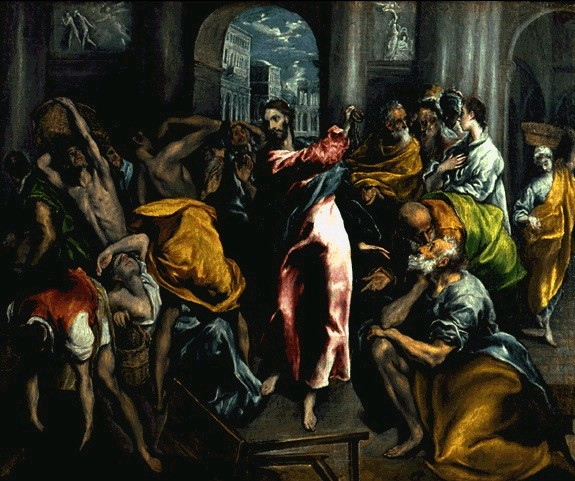
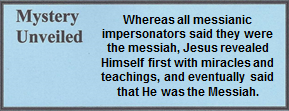
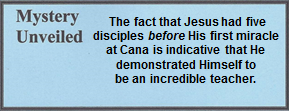
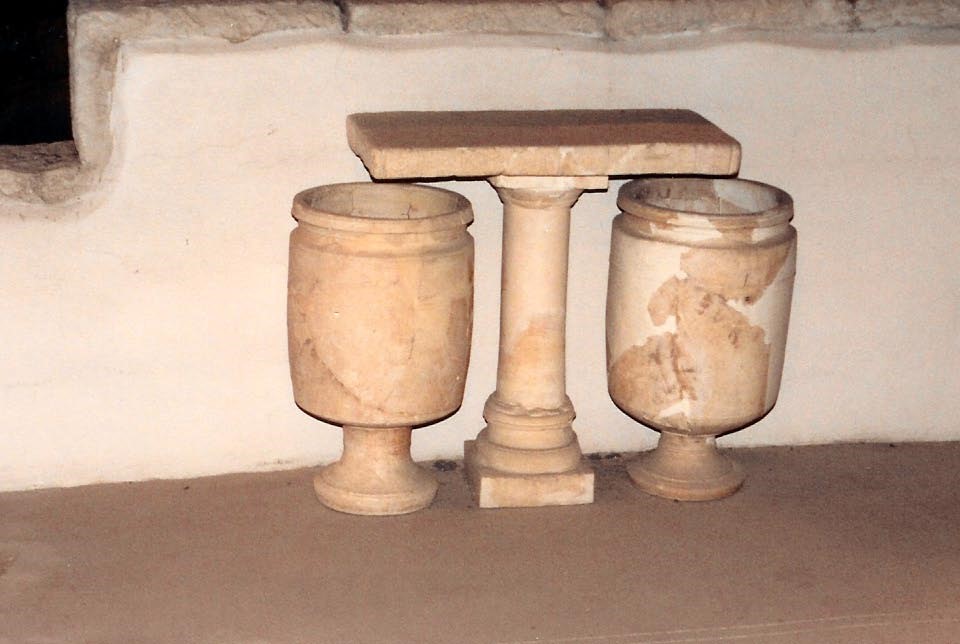
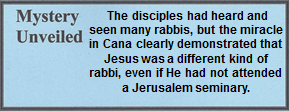
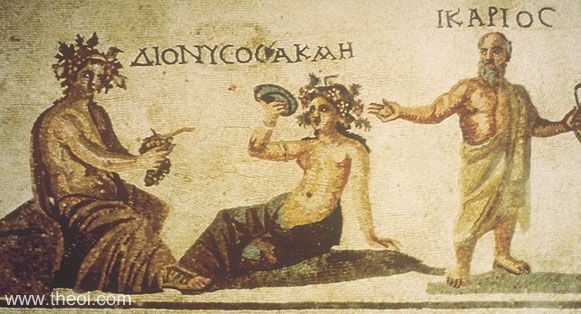






 05.05.04.D. A ROMAN RELIEF OF A BANKER AT WORK. This relief carving shows a banker with his money bag and book of records at work. The huge volume of money donated to temples, as well as deposits held for security reasons, resulted in temples becoming banking institutions throughout the ancient world. Relief on a Roman era funerary stele from Hungary. Photograph by Wikipedia Commons.
05.05.04.D. A ROMAN RELIEF OF A BANKER AT WORK. This relief carving shows a banker with his money bag and book of records at work. The huge volume of money donated to temples, as well as deposits held for security reasons, resulted in temples becoming banking institutions throughout the ancient world. Relief on a Roman era funerary stele from Hungary. Photograph by Wikipedia Commons.